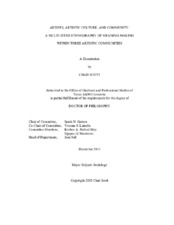| dc.description.abstract | This multi- sited ethnography of artists, artistic culture, and community aimed to understand the meaning-making activities of artistic producers (poets) and consumers (audiences) within three artistic communities across the Southwest Region of the U.S. Participant observations, situational interviews, 30 participant interviews, and field notes were collected over a three year period.
Throughout the study, data were analyzed using an adapted version of the constant comparative method. Themes and subthemes constructed from the analysis were organized into two sections: Artists and Artistic Production focused on the meanings of slam poetry from the perspective of poets; and Audience, Community and Participation, which focused on the meanings held by various audiences who attend slam poetry events.
From the perspective of poets, slam poetry was meaningful because it provided opportunities to create work within an artistic community. Working collaboratively increased artistic production, while also allowing poets to learn from one another. For many poets writing and performing slam poetry was a therapeutic outlet, a way to process life and challenging experiences. To varying degrees, nearly all poets utilized the format of slam poetry to construct and perform aspects of their identity they are unable to express in other arenas. By rendering the self-explicit, a process of bringing “backstage” discourses to the “front stage,” poets were able to recall, reframe, and retell challenging experiences in a way that was meaningful and personally enriching. Whether for self-reflexive purposes, speaking to collective representations, engaging in political speech, or for pedagogical reasons, rendering the self-explicit was a form of identity and boundary work for many poets.
From the perspective of audiences, slam poetry events were a place where they were able to share similar interests with a supportive group of people. Many participants developed and maintained close friendships with fellow members of the community, some describing their relationships as family. Additionally, many attended slam poetry events because discourse within the space resonated with their experiences and challenged their thinking. Indeed, many viewed slam poetry events as one of the few public spaces where they were able to engage in meaningful discourse relating to marginalized experiences and issues of social justice.
For poets and audiences alike, slam poetry communities provided a space that encouraged meaningful communication. The intersection of contexts, where interactions between front stage/backstage discourses occurred, created a transitional space which prompted moments of shared intimacy and understanding between participants. Some participants described these moments as transformational experiences that lead to new understandings of self and society, and encouraged a shared sense of community and belonging. | en |


